Instructions for transplanting honeysuckle to a new place in stages
Honeysuckle is not picky when it comes to care: it is frost-resistant and not picky about soils. It has a high yield and bears fruit for up to 25 years, and with good care - longer. The shrub does not require mandatory replanting. But sometimes situations arise when you have to change the place where it is grown.
We'll tell you why this can happen, when and how to properly transplant honeysuckle to a new location.
Why transplant honeysuckle to a new place in the fall and is it possible to do it?

Honeysuckle grows in one place and bears fruit for up to 25-30 years. Frequent replanting of the shrub is not required - this does not affect its productivity, growth and development.
Reasons for transplantation:
- the bush has grown too much to the sides;
- the bush displaces neighboring plants;
- redevelopment of the territory;
- The wrong location was initially chosen.
Honeysuckle is prone to early vegetation; the first warm temperatures in spring lead to bud growth and flowering of the plant. Therefore, it is difficult to replant it in the spring.
In the case of spring transplantation, the shrub will require more careful care (ample watering, loosening and fertilizing) and will take root with difficulty.
In autumn, honeysuckle enters a dormant stage and prepares for winter. This is the most suitable time for transplantation.
Optimal transplant timing
The best time to transplant honeysuckle is autumn. The procedure is carried out in September - October (in some regions until mid-November), until the soil freezes.
Where to transplant
Choose a place for planting that is illuminated.It is important to consider the direction of the sun's rays during the day. Honeysuckle produces maximum yield when its upper branches are in the sun and its lower branches are in the shade.
To prevent gusts of wind from breaking the fragile branches of the bush, it is transplanted not to hillocks, but to lowlands. They avoid drafts - the bush does not like them. However, the transplant site must be ventilated.
If several bushes are transplanted, a distance of 1.5 m is maintained between them.
Neighborhood Rules
When choosing a location, pay attention to what plants will grow in the neighborhood. Honeysuckle is planted next to currants, lilacs or mock orange, which will protect it from gusts of wind. The shrub gets along well with apple, pear and plum trees.
Poplar, chestnut, walnut, and apricot interfere with the plant’s development and take away light and moisture. Do not plant it next to juniper, as it can spread rust, which is difficult to cure.
Selecting bushes for replanting
Honeysuckle bushes without signs of diseases or pests are suitable for replanting. Stunted bushes are discarded.
Important! Experienced gardeners recommend replanting shrubs that have not reached five years of age. Old plants do not take root well and often die.
Preparing honeysuckle

Dry and damaged branches on the bush are pruned and the shoots are shortened. The optimal height of the bush is up to 0.5 m. Damaged and dry branches are cut off from young bushes; shoots are not shortened.
The soil around the bush is watered. The bush is carefully dug up so as not to damage the roots. To make adaptation faster, honeysuckle is replanted along with the ground. They begin to dig along the perimeter of the crown, since the root system grows to the length of the branches.
The ditch is deepened at an angle to form a cone. Any roots that come across are cut with a shovel.The bush is taken out, placed on film, wrapped and transferred to the transplant site.
Soil preparation
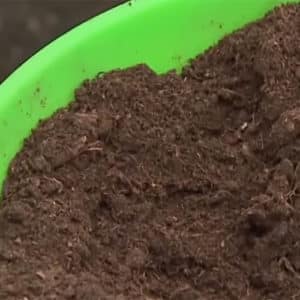
Honeysuckle grows well in any soil. But you should not replant it in places with close groundwater: excess moisture negatively affects the growth of the plant and leads to rotting of the root system.
The best option for replanting is loamy and sandy loam soils with a neutral acidity level.. High acidity is reduced by liming. When digging, add dolomite flour (0.2-0.4 kg per 1 m²).
Before transplanting, holes are made in the soil. The excavated soil is fertilized with ash (1 l), compost (1 bucket) and superphosphate (100 g).
How to properly transplant honeysuckle to a new place
More often honeysuckle transplanted into holes, but if there are a large number of bushes, the trench planting method is used.
Trench method
The trench method is often used when planting new seedlings. It is also used when transplanting several bushes.
Before replanting, dig a trench 0.5 m wide and 0.3 m deep. A drainage layer of pebbles or broken bricks is laid at the bottom of the trench. Add compost or humus (1 bucket), superphosphate (100 g), wood ash (1 l) to the dug soil.
Transfer the dug bush with a lump of earth and place it vertically in the trench. The roots are straightened and sprinkled with earth on top. Bushes should be planted at a distance of at least 1.5 m.
The planted bushes are watered. The soil is mulched with hay, sawdust or peat to protect plants from frost and retain moisture in the soil.
Pit method
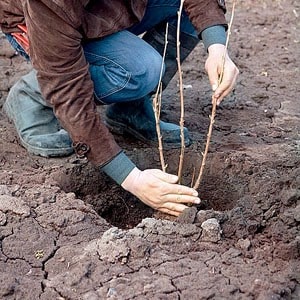 7 days before transplantation, prepare a 1x1 m hole. A drainage layer of fragments of brick, pebbles or crushed stone is laid at the bottom. A mixture is prepared from the excavated soil. Add a bucket of compost, 1 liter of ash, 100 g of superphosphate to it.Then 2/3 of the fertilized soil is poured into the hole. 2 buckets of water are poured on top.
7 days before transplantation, prepare a 1x1 m hole. A drainage layer of fragments of brick, pebbles or crushed stone is laid at the bottom. A mixture is prepared from the excavated soil. Add a bucket of compost, 1 liter of ash, 100 g of superphosphate to it.Then 2/3 of the fertilized soil is poured into the hole. 2 buckets of water are poured on top.
After the soil has settled, make a hole. Since the roots of the shrub lie shallow, its depth is no more than 0.5 m. The dug out bush is placed in a recess so that the root collar is level with the ground surface. Straighten the roots and sprinkle with the remaining fertilized soil. The transplanted bush is watered.
Then the soil is mulched with leaves, sawdust or peat. This provides protection for the root system in cold weather.
Care after transplant
It is important to control soil moisture. If the weather is dry and warm after transplantation, then the bush is watered once a week. Watering rate is 1.5 buckets of water per bush.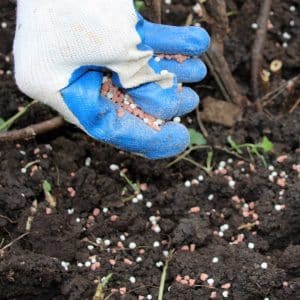
Edible honeysuckle is not afraid of cold weather. It can withstand frosts down to −45°C, so it is not covered for the winter. To prevent branches from breaking off due to heavy snow, they are tied into bundles and bent to the ground.
Decorative honeysuckle is less frost-resistant. But it is covered and mulched only in the first years after planting. The climbing stems of the young plant are removed from the supports, carefully bent to the ground and covered with spruce branches.
In the spring, standard care begins for the crop, which consists of fertilizing, watering, loosening, pruning and treatment for diseases and pests.
Top dressing
In the spring, before the buds open, the bush is fertilized with ammonium nitrate. In dry form, it is applied to the soil under each bush, 15 g per 1 m². Or water with urea solution - 1 tbsp. l. for 10 liters of water.
In the fall, after the end of the fruiting period, the soil under the bush is fertilized with a solution of nitrophoska or nitroammophoska - 25 g per 10 liters of water. Organic fertilizers are applied for 3-4 years (10 liters per 1 bush).
Watering
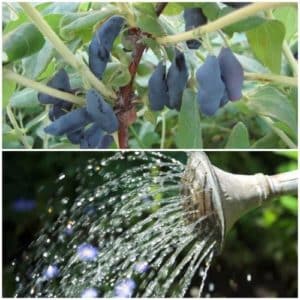
Water the plant moderately. The norm is 1.5 buckets for one bush.
During the dry period, it is watered abundantly, the norm is increased to 2.5 buckets.
Lack of moisture causes the berries to grow bitter.
Loosening
The soil is loosened shallowly (7-8 cm), because the roots of the bush lie in the top layer of soil.
If the ground under the bush is mulched, it does not need to be loosened.
Trimming
In the spring, sanitary pruning is carried out - old, diseased, broken branches are cut from the bushes.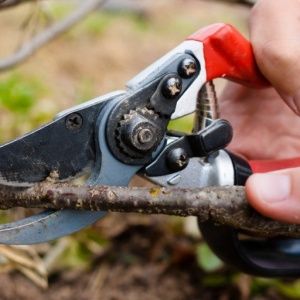
Formative pruning is carried out from the fourth year. The bush is given a spherical shape. In the central part, thick shoots are cut to the point of lateral growth. Branches growing inward and spreading along the ground are removed.
Anti-aging pruning is carried out on bushes older than 8 years to prolong the life of the bush. Remove old branches and some trunks.
Once every 3-4 years, detailed pruning is carried out to increase fertility: damaged and non-viable shoots are removed.
Disease and pest control
Resistance to diseases and pests of honeysuckle is average. The shrub is affected by viral and fungal diseases:
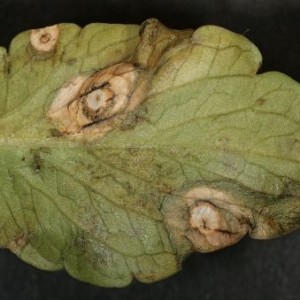
- Powdery mildew - appears when there is insufficient or improper watering. The leaves become covered with white powdery spots. Moderate watering is important for prevention. When signs of disease appear, the bush is sprayed with a solution of Myclobutanil (30 g per 10 liters of water).
- Cercospora - a fungal disease in which brown spots with a red edge appear on the leaves. The leaves then dry out and die. The affected parts of the plant are cut off and burned, the bush is treated with a 3% solution of Bordeaux mixture.
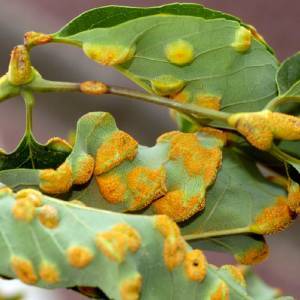
- Ramulariasis - in spring, grayish-white spots appear on the leaves, which gradually increase in size and darken. The disease affects the stems and stalks of honeysuckle.In case of damage, the bush is sprayed with “Fundazol” (10 g per 5 liters of water). Or use a solution of wood ash (100 g per 1 bucket of water) - water the root zone and spray the plant.
- Leaf mottling - Dark red or brown spots appear on the leaves. The leaves turn yellow and fall off. To combat the disease, the affected leaves are cleaned and burned. If the disease is advanced, the plant is disposed of.
This is interesting:
Why does powdery mildew appear on cucumbers and why is it dangerous?
How to treat beet cercospora and prevent the occurrence of this disease.
Diseases and pests of parsley: photos, methods of control and prevention.
The main pests of shrubs:
- Honeysuckle mite - sucks the juice from the leaves, as a result the leaves wither and curl. To combat insects, the plant is sprayed with a solution of Actellica (7 ml per 10 liters of water) or Confidora (1 g per 10 liters of water).
- Honeysuckle aphid - sucks juice from shoots. To combat, use “Aktellik” (7 ml per 10 liters of water) or “Confidor” (1 g per 10 liters of water).
- Shchitovka - sticks to the bark and sucks the juice from the branches. To get rid of the insect, the plant is sprayed with Actellika solution (7 ml per 10 liters of water), and the root zone is watered with Rogor-S solution (6 liters per hundred square meters of land).
The nuances of transplantation depending on the growing region

The timing of transplanting honeysuckle to a new location in the fall depends on the climatic conditions of the region. In central Russia and the Moscow region it is held in mid-October. Honeysuckle is highly frost-resistant, but does not tolerate sudden warming in winter. Such weather conditions are typical for central Russia, so gardeners in these regions should take care of covering the shrubs for the winter.
In the northern regions, they are replanted in early September so that the shrub has time to take root before winter and can survive severe frosts.
In the southern regions, the procedure is carried out in late October - early November. In hot and dry weather, transplanted honeysuckle does not take root well - it is important to periodically water it and loosen it.
Conclusion
Honeysuckle is transplanted in the fall, when the plant is dormant. They select the right place and favorable neighbors, fertilize the soil, carefully dig up and place the plant in a new place.
If all the rules are followed, the bush quickly takes root, withstands the winter, and pleases with the harvest and attractive appearance the next year.